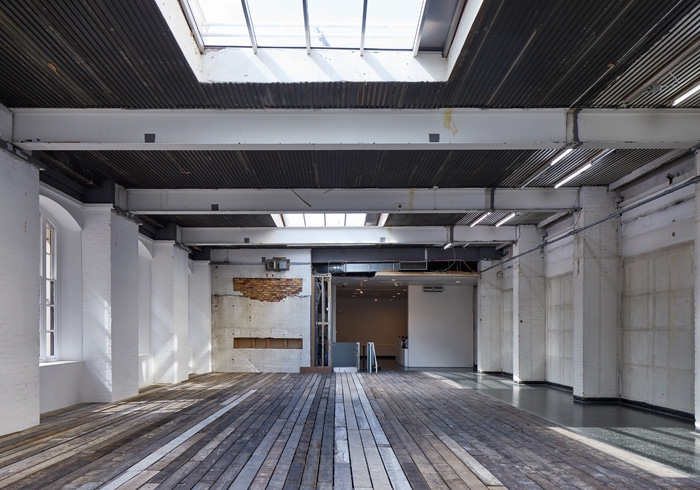Institute of Contemporary Arts, London, 6 May – 2 July
When Martin Creed’s Work No. 227: The lights going on and off was nominated for the 2001 Turner Prize, one member of the public registered her disgust by launching a volley of eggs against the white walls of the Tate Britain gallery in which it was installed. Stuart Middleton’s exhibition at the ICA preempts even such a futile protest by dematerialising not only the work of art but also the institutional architecture.
The lower gallery has been stripped of its suspended ceiling and temporary walls, exposing the building’s tarnished steel entrails and crumbling masonry. An invigilator sits forlornly on a rickety wooden platform constructed of reclaimed domestic floorboards, backdropped by an inverted ziggurat of burnt ochre and sickly yellow brickwork from which the concrete filling spills. Her presence, more closely resembling the vigil of a mourner than of a security guard, contributes to the pervasive sense of loss. The upstairs gallery is equally bereft, the shadowed lines and extruding nails on the bare walls contrasting sharply with the stuccoed grandeur of the ceiling.
The space is empty apart from a large screen on the far wall of the second gallery displaying a stop-motion animation. The video depicts a mangy black dog trapped in a shallow white space, not unlike the gallery prior to its renovation, moving through a series of everyday behaviours. Curled up in a corner dreaming of rabbits, its legs kick out in fitful chase; it licks and barks noisily at the screen; wags its tail left and right against the floor to beat out a rhythm against the boredom. The video lasts only a few minutes before looping, but amidst these bare rooms, the black dog – traditionally a portent of death or depression – offers a melancholy companionship.
Beat’s most obvious precursor is Cerith Wyn Evans’s 2006 exhibition at the ICA, which emptied the downstairs gallery, exposing it to scrutiny from the street, and featured two looped films upstairs. Yet the desolate space causes the mind to wander, encouraging associations with things as diverse as Joseph Beuys’s I Like America and America Likes Me (1974), for which the artist spent three days locked in an empty New York gallery with a coyote, Jean Genet’s description of Giacometti’s sculpture of an emaciated dog as the ‘supreme magnification of solitude’ and even the canine pseudonym (‘R. Mutt’) with which Marcel Duchamp signed Fountain (1917) (some wag has tagged the signature on one of the urinals in the gallery’s male toilets). But the work is strongest when considered as an exercise in absurdism – a darkly humorous meditation on futility and the possibility of at least partial redemption – and weakest when understood as satire: the reclaimed floorboards and bare brickwork as, for example, a comment on the fad for distressed interior architecture.
A short story written by the artist to accompany the exhibition upsets the balance. The narrator delivers an embittered tirade on the failure of his ex-colleagues in ‘motorway network hospitality’ to recognise his ‘raw creativity’, lampooning a culture in which everyone believes themselves to be an artist. The story reads like a disavowal (it finishes, ‘I quit’), and its sardonic tone undermines (at least for me) the productive ambivalence towards the production and exhibition of art that the rest of the show implies. By seeming to ironise his own practice, Middleton distances himself from it, and at least partially defuses it. This is the least convincing of his assaults on the structures that frame a work of art.
From the September 2017 issue of ArtReview
